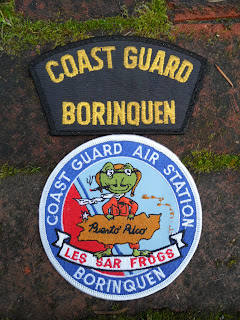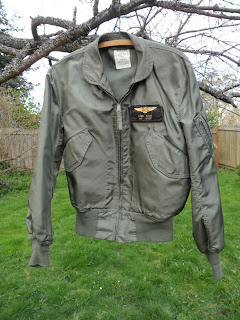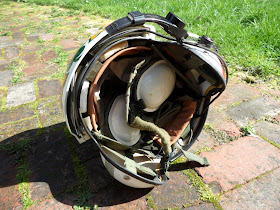Since my last posting was about my old fight helmet from when I flew on HH65A Dolphin helicopters down in Puerto Rico, I figured I ought to climb into the attic and drag out some more of my old gear so I could make it a complete set!
United States Air Station Borinquen, Ramey, Puerto Rico 1986 - 1989
When I first started flying, back in 1986, the USCG was still issuing out military green flight suits. I flew a lot of hours in those green suits and I think they really looked sharp. Then, about 1987, the USCG switched over to what we called NASA flight suits. They were basically the same as the green ones, except they had shoulder epilates and were blue. All of our flight suits had our air station "SAR Frogs" patch sewn on the shoulder (SAR for Search & Rescue, and Frogs because we flew French helicopters). The leather name tags were made up in the survival shop and were Velcro backed so they could be removed.
Over the top of our flight suits, we wore a combination survival vest and flotation / escape re-breather. The vests were maintained by our survival shop and were always hanging ready to go. We were not issued with a vest, but rather checked one out as we headed out to the helicopter for a flight. There were pencil flares, signal mirror, radio beacon, strobe light, and a dye packet in the pockets, as I recall. In the yoke of the vest, there was an inflatable flotation bladder that could be filled with either co2, pure oxygen, or by mouth through a manual fill tube. You could tell the difference between the two cartridges (oxygen, co2) by the shape of the plastic bead on the end of the pull cord (I believe the co2 was round and the oxygen was square). If you were trapped in a sinking helicopter, you could fill the bladder with the pure oxygen and then breath it in and out through an attached mouthpiece. This would give you anywhere from a few minutes to ten minutes of breathing, time to get out of the helicopter and swim to the surface.
Here is a vest that is just the shell. All of the survival gear and inflatables have been removed.
Many of us carried an issued "knee board" that was made of aluminum and had a built-in. battery powered light, a pencil sharpener, pencil holder, pad of paper, and a pencil. I used mine to make flight notes of things like navigational positions, radio frequencies, contact units, mission info etc. In fact, the pad of paper on my knee board still has the notes from my last Search & Rescue flight:
On May 7, 1988, While flying on USCG Helicopter 6511, I lowered two pumps to the M/V Isabell Mitchell. The Isabell Mitchell was a small coastal freighter that was hauling a hold full of sugar. She lost her steering and ran aground on a reef off the South East corner of the Dominiquen Republic. The ship was sinking slowly and had the added problem of having a hold full of wet sugar that was starting to act like cement. We dropped the pumps, and stayed on scene for as long as we could, then headed back to the Air Station.
Along with our flight gear, we normally took our USCG ball caps along for any time that we were out of the helicopter for refueling, etc. These were the same caps that we wore around the hangar while doing our "regular" work. It was pretty customary to wear your petty officer's device or flight wings pin on the front of the cap, but you had to bend the tabs over and NOT use the pin clasps. This was to make sure that the device did not fall off and get sucked into the intake of the jet turbine engines!
In the Caribbean, it was pretty darn warm pretty much year round so we really didn't wear flight jackets, but occasionally when we were on a longer flight, or one that might involve several refuelings, we would throw our jackets in. Here's mine, complete with a set of flight wings pinned over the embossed ones on the name tag. The jacket was mostly worn around the base if needed, or when away on USCG business.
The seats in the HH65A Dolphin helicopters were HARD! To help with this, our survival shop purchased inflatable Thermarest seat cushions and issued them out to everyone. Three hours sitting on a hard seat while flying was pure HELL until we got these cushions :) Here is mine, with a little self applied "trench art".
We wore our regular green and gray flight gloves at all times while flying. The Flight Mechanics (Me) also carried a single left-hand glove to wear over the regular flight glove to protect your hand while running the hoist cable in and out during rescues. As you can see, I got plenty of time using the rescue hoist!
I almost forgot my trusty USCG issue flight glasses with the optional ear-hook frames..........
And last but not least, the trusty survival knife. I profiled this knife in an earlier post......... click this link to read more about it; USCG SURVIVAL KNIFE


















































